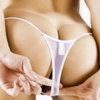The first skateboardThe first skateboard originated sometime in the 1950s and coincided with the initial popularization of surfing in California. The earliest skateboards were homemade and were constructed of flat wooden planks attached to roller-skate trucks and wheels. Skateboarding was originally called "sidewalk surfing" and early skaters emulated surfing style and moves. Skateboards may or may not have evolved from "crate scooters." Crate scooters preceded skateboards, and were essentially similar except for having a wooden crate attached to the front, which formed rudimentary handlebars. In the film Back to the Future, Marty McFly is seen confiscating such a scooter from an unsuspecting 50s youth, and ripping the crate off to fashion an improvised skateboard.
In the mid 1960s skateboarding became something of a craze. A number of surfing manufacturers such as Hobie and Makaha started building skateboards that resembled small surfboards and assembling teams to promote their products. The popularity of skateboarding at this time spawned a national magazine, skateboarder magazine and the 1965 international championships were broadcast on national television. The growth of skateboarding at this time can also be seen in Makaha's sales figures which quoted $4 million worth of boards between 1963 and 1965. Yet by 1966 sales had dropped significantly and skateboarder magazine had stopped publication. Skateboarding's popularity dropped and remained low until the early 1970s.
Second generationIn the early 1970s, Frank Nasworthy started to develop a skateboard wheel made of polyurethane. The improvement in traction and performance was so immense that the popularity of skateboarding started to rise rapidly again, and companies started to invest more in product development. Many companies started to manufacture trucks (axles) especially designed for skateboarding. As the equipment became more maneuverable, the decks started to get wider, reaching widths of 10 inches and over in the end, thus giving the skateboarder even more control. Banana board is an term used to describe skateboards made of polypropylene that were skinny, flexible, with ribs on the underside for structural support and very popular during the mid-1970s. They were available in a myriad of colors, bright yellow probably being the most memorable, hence the name.
Manufacturers started to experiment with more exotic composites, like fiberglass and aluminum, but the common skateboards were made of maple plywood. The skateboarders took advantage of the improved handling of their skateboards and started inventing new tricks. Skateboarders, most notably the Z-Boys, started to skate the vertical walls of swimming pools that were left empty in the 1976 California drought. This started the vert trend in skateboarding. With increased control, skateboarders could skate faster and perform more dangerous tricks, such as slash grinds and frontside/backside airs. This caused liability concerns and increased insurance costs to skatepark owners. Many skateparks went out of business and were torn down. By the beginning of the 1980s, skateboarding had died again.
Third generationThe third skateboard generation, from the early/mid eighties to early nineties, was started by skateboard companies that were run by skateboarders. The focus was initially on vert ramp skateboarding. The invention of the no-hands aerial (later known as the ollie) by Alan Gelfand in 1976 [1] made it possible for skaters to perform huge airs off vertical ramps. While this wave of skateboarding was sparked by commercialized vert ramp skating, a majority of people who skateboarded during this period never rode vert ramps. Because most people couldn't afford to build vert ramps or didn't have access to nearby ramps, street skating gained popularity. In the mid-eighties, street skating was performed on wide vert boards with short noses, slide rails, large soft wheels. Skateboarding, however, evolved quickly in the late 1980s to accommodate the street skater. Since few skateparks were available to skaters at this time, street skating pushed skaters to seek out shopping centers and public and private property as their "spot" to skate. Public opposition, and the threat of lawsuits forced businesses and property owners to ban skateboarding on their property. By 1992 only a small fraction of skateboarders remained as a highly technical version of street skating combined with the decline of vert skating produced a sport that lacked the mainstream appeal to attract new skaters.
 Current generation
Current generationThe fourth and current generation of skateboards is dominated by street skating. Most boards are about 7¼ to 8 inches wide and 30 to 32 inches long. The wheels have an extremely hard durometer (approximately 99a). Additionally, very high durometers offer the benefit of reduced drag on hard surfaces which results in an overall faster ride. The wheel sizes are relatively small so that the boards are lighter, thus making tricks more manageable. Today, modern wheels are currently around 48 to 60 mm in diameter and advances in technology have made them extremely light compared to the wheels of the eighties. Most decks are still constructed out of Canadian Maple, with 7-plys being the industry standard for strength and durability. Board styles have changed dramatically since the 1970s but have remained mostly alike since the mid 1990s. The contemporary shape of the skateboard is derived from the freestyle boards of the 1980s with a largely symmetrical shape and relatively narrow width. During the 90s ramp or vert skateboarding dropped in popularity.




